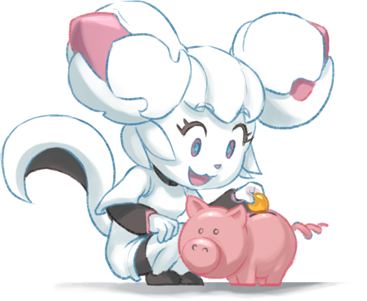25 år med Krita!
- Halla Rempt
Tjugofem år. Ett kvarts sekel. Så länge har vi jobbat på Krita. Nåja, det som skulle bli Krita. Det började som KImageShop, men det namnet sköts i sank av en nu sedan länge död tysk advokat. Sedan döptes det om till Krayon, och det namnet var också sköts också ner. Sedan döptes det om till Krita, och det namnet har blivit kvar.
Jag började delta i Krita först 2003, när Krita fortfarande var en del av KDE:s svit av produktivitetsprogram, Koffice, senare omdöpt till Calligra ... Och jag blev [underhållsansvarig för Krita 2004](https://marc.info/? l=kde-kimageshop&m=107877497900328&w=2), när Patrick Julien lämnade över stafettpinnen. Det betyder att jag har varit med i Krita ungefär tjugo av de tjugofem åren, så jag hoppas att du, kära läsare, förlåter mig för att jag gjort det här till ett riktigt personligt inlägg. En mycket stor del av mitt liv har varit knutet till Krita, och det syns.
Men låt oss först gå tillbaka till förr när jag behövde ett digitalt målarprogram. De första fröna till Krita lades 1998, till och med tidigare än den första koden. På den tiden var Linux spännande, och det fanns massor av projekt som försökte skapa fantastiska program för Linux. Ett av projekten var GIMP, och ett annat var Qt. Det första var ett program för digital bildmanipulation, det andra en verktygslåda för att skapa användarvänliga program i C++. Men GIMP använde inte Qt, det använde sin egentillverkade verktygslåda för användargränssnitt (även om det ursprungligen använde Motif, som inte var öppen källkod). En beundrare av Qt, Matthias Ettrich, gjorde en experimentell konvertering av GIMP till Qt och gav en presentation om det på Linux Kongress 1998. Det togs inte emot väl och resulterade i den sortens gnabb som är typiskt för öppen källkod. Folk var unga och humöret var hett.
Ja, när det är fallet är den enda lösningen att ta tag i det själv, och det är just vad som hände. Det tog flera misslyckade försök, men sista dagen i maj 1999 startade Matthias Elter och Michael Koch KImageShop. Läs brevet, eftersom det är rätt lustigt hur vi gjorde i stället för att följa den ursprungliga visionen (KOM var en Corba-liknande grej, och om du aldrig har hört talas om Corba, är det förmodligen för att Corba var en hemsk idé.)
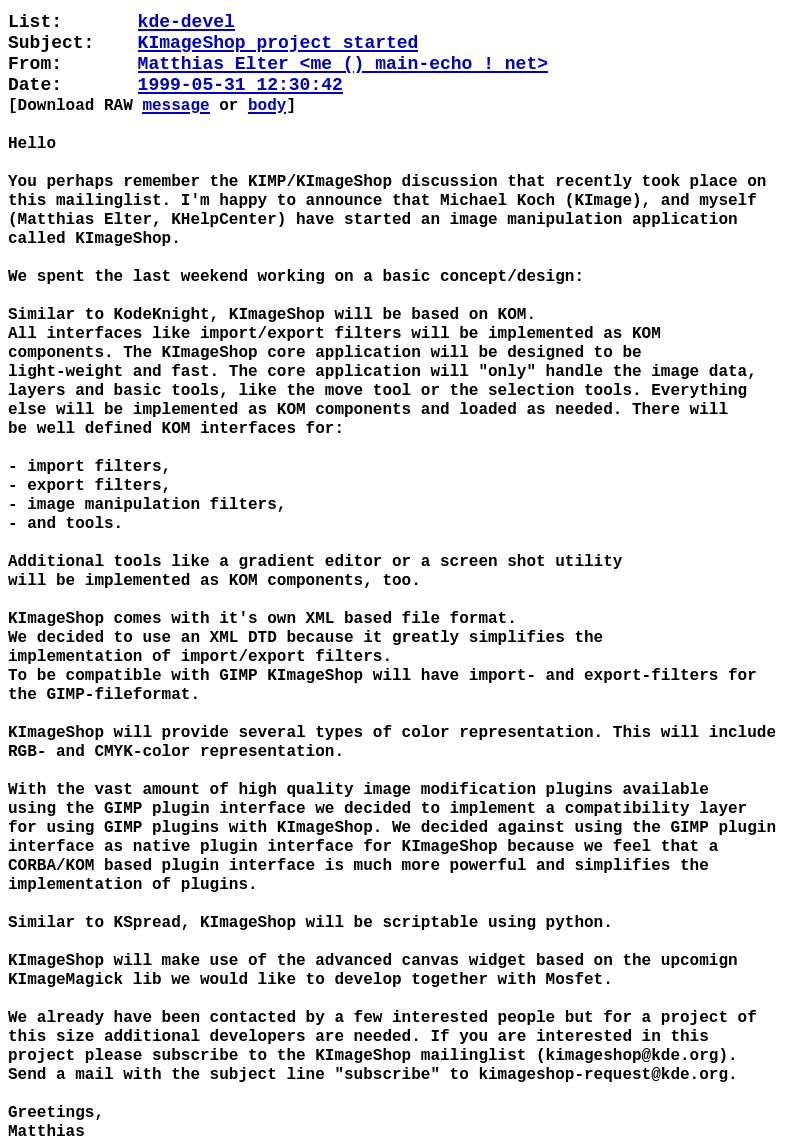
Utvecklingen startade, och tro det eller ej, finns det fortfarande en del verklig kod som går tillbaka till den tiden i Kritas kodbas, även om det mesta av den återstående koden är inledande och avslutande parenteser.
Och sedan avbröts utvecklingen, för det går inte lätt eller snabbt att skapa ett korrekt bildmanipuleringsprogram. Och sedan började den igen, och slutade igen, och började igen. Det fanns flera underhållsansvariga innan jag började letade efter en snygg kodbas med hög prestanda för ett målarprogram 2003. Jag kunde inte C++; men jag hade skrivit den första boken om att använda Python och Qt tillsammans.
Krita hade skrivits om till den grad att den inte ens hade något målarverktyg, så det var det första jag ville ha. Det var inte lätt!
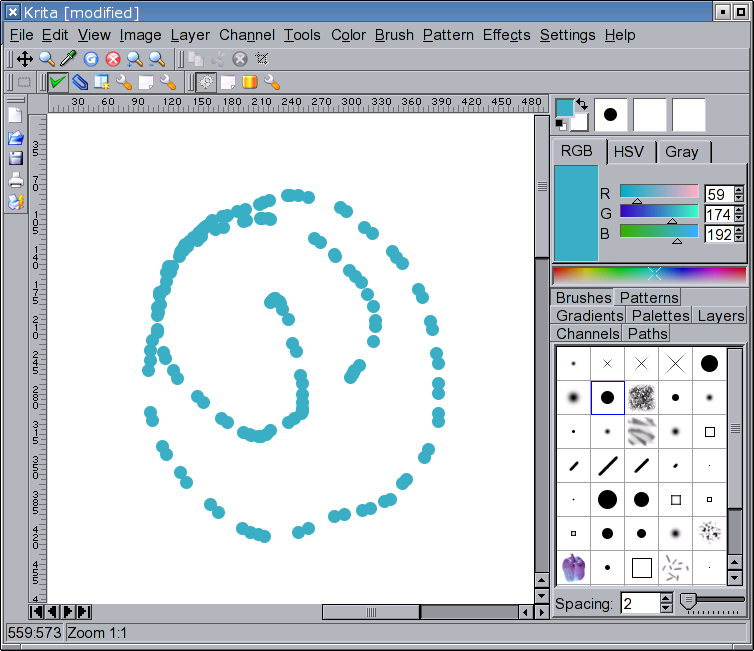
Men ... Att vara öppen med att det inte är lätt innebar att folk blev intresserade, och vi började få bidragsgivare. Och så, 2004, hade vi ett litet team av entusiastiska personer. Det hände mycket under det året; Camilla Boemann skrev om kärnan i Krita så att vi hade lager med automatisk storlek, Adrian Page skrev ett OpenGL-baserat gränssnitt, Cyrille Berger lade till de första inslagen av insticksprogram och skript. Vårt tillvägagångssätt var dock fortfarande ganska tekniskt, och vi lyckades inte göra en utgåva.
Det var först 2005 som vi gav ut Krita som en del av Koffice 1.4. Fortfarande väldigt omoget, men alla var överens om att det var lovande, och vi fick fina recensioner i några Linux-tidskrifter, som fortfarande fanns 2005.
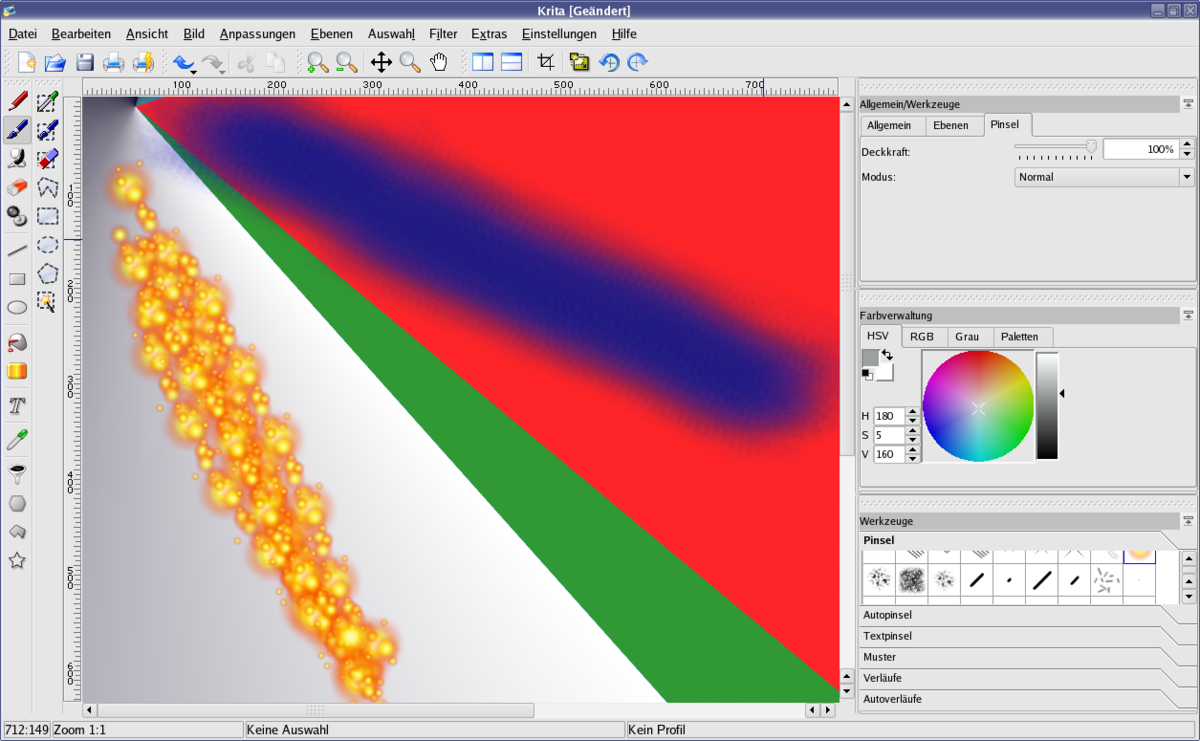
Sedan kom 2006. Och Krita 1.5 släpptes med stöd för CMYK färghantering. Krita 1.5 hade också den kortlivade funktionen för äkta färgblandning av akvarellager, men den var för komplicerat att underhålla. Och samma år släppte vi Krita 1.6: Linux Journal kallade det toppmodernt. Vi tyckte att det var en ganska mogen utgåva, men konstnärer som gav oss återkoppling tyckte fortfarande att det saknades mycket.
Och så slog katastrofen till. Qt3 nådde slutet av sin livslängd och Qt4 gavs ut. Konverteringsinsatsen var enorm och tog evigheter, också för att vi, dumt nog, bestämde oss för att skriva om mycket av koden i 1.x för att göra det möjligt att dela komponenter mellan program i Koffice. Omskrivningen tog hela 2007, 2008 och halva 2009.
Under tiden, när vi desperat försökte fixa alla fel som konverteringen och omskrivningen introducerade, höll vi vår första insamling för att skaffa Wacom ritplattor att testa Krita med, komplett med pennor. Jag använder fortfarande Wacom Intuos 3 som vi fick för länge sedan!
Under 2009 släppte vi sedan Krita 2.0. Det var inte riktigt användbart, men det var viktigt för oss att få fram något som vi kunde få folk att testa. Krita 2.1 släpptes också 2009. Vi fick också vår [första sponsrade utvecklare, Lukáš Tvrdý](https://dot.kde.org/2009/12/02/krita-team-seeking-sponsorship-take-krita-next -level), som specifikt hade till uppgift att rätta alla fel. Senare förbättrade han också prestanda för Kritas penslar.
I takt med att Krita fick erkännande fick vi mer och mer återkoppling, och 2010 bestämde vi oss för att ha en stor sprint i Deventer där vi skulle avgöra vad vi ville att Krita skulle vara för våra användare. En kopia av Photoshop? En kopia av GIMP? En kopia av Corel Painter? Eller något som var helt eget. För vem gjorde vi Krita?
Svaret är sant också idag: vi gör Krita för digitalkonstnärer som skapar konst, mestadels från grunden. Att måla med Krita ska vara roligt för konstnärer av alla slag, över hela världen.
Men det skulle dröja innan vi nådde målet. Krita 2.2 och Krita 2.3 kom 2010. Vi trodde att Krita 2.3 var redo för konstnärer, men det var först med Krita 2.4 och 2.5 2012 som Krita verkligen blev ganska bra. Faktum är att vi hade ett skarpt fokus: under några år var vårt stridsrop: "Gör Krita användbar för David Revoy!". I viss mån var det fånigt, men också i viss mån seriöst. Vi tillbringade tid under utvecklingssprintar med att observera konstnärer och låta dem direkt kommentera vad de gillade och inte gillade, utan att de observerande utvecklarna fick säga något, vare sig som motbevis eller för att hjälpa konstnären.
Under tiden hade jag skapat Krita-stiftelsen så att vi kunde göra insamlingar för att sponsra heltidsutvecklare. Den första utvecklaren vi sponsrade var Dmitry Kazakov, som fortfarande är huvudutvecklare av Krita.
Då var Krita fortfarande en del av KDE:s kontorssvit, men den hette nu Calligra, på grund av en oändlig konflikt med bara en utvecklare av Koffice, underhållsansvarige för KWord. All den energi som spenderades på den konflikten kunde ha gått till utveckling, det var ett enormt slöseri. Från dagarna med Calligra och framåt gick utvecklingen mycket smidigare. Nokia var nu involverad i Calligras utveckling, och den resulterande förbättringen i de centrala biblioteken som alla program använde bidrog också till att förbättra Krita, men omvänt belastas vi fortfarande idag av den komplexitet som krävs för att stödja en mycket mångsidig uppsättning program.
Åren gick. 2013 var helt händelselöst. Vi gjorde våra utgåvor (2.6, 2.7), gjorde våra insamlingar, lade till funktioner (som animeringsstöd), skapade en version av Krita med ett speciellt användargränssnitt för användare av ritplattor och surfplattor (sponsrat av Intel: vi har fortfarande en fantastisk relation med Intel, vår huvudsponsor av utvecklingsfonden). Det var fantastiskt att se konst som folk skapade, fantastiskt att få återkoppling från användare och helt enkelt roligt att ta itu med utvecklingen.
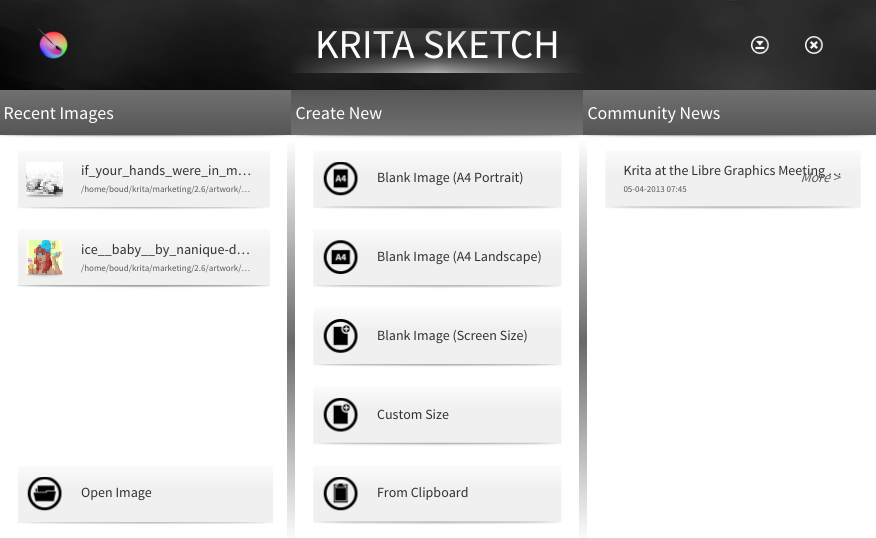
Under 2014 konverterade vi Krita till Windows, också på grund av versionen av Krita för ritplattor och surfplattor. Och vi släppte elva versioner av Krita 2.9, vilket verkligen var en väldigt fin utgåva.
Vi hade även vår första Kickstarter-kampanj 2014. Kickstarter var nytt och fräscht då, och det var riktigt spännande. Vi fick nästan 700 personer att sponsra Krita! Och vi konverterade Krita till MacOS. Under en tid gjorde vi en kampanj med Kickstarter varje år, och de var roliga både för oss och för våra utvecklare. Vi satte upp mål och lät folk rösta på vad de ville att vi skulle arbeta med.

Jag hade fortfarande ett heltidsjobb då, så allt var arbete som gjordes på kvällar och helger, och på tåget under min pendling.
Vi började också konvertera Krita, igen, denna gång till Qt5. Det var inte lika svårt som porten från Qt3 till Qt4, men vi förlorade stödet för versionen av Krita för surfplattor eftersom Qt5 gjorde det omöjligt att integrera vår OpenGL-baserade duk på rätt sätt i pekversionen av Qt5:s bibliotek. Vi spenderade månader och en hel del pengar på det, men det kom ingen vart.
Sedan bröt jag axeln och förlorade mitt dagliga jobb på Blue Systems, och plötsligt behövde Krita Foundation betala mig också. Lyckligtvis hittade vi en sponsor för konverteringen till Qt5, som blev mitt första sponsrade projekt.
Vi gav ut Krita 3.0 2016: det var inte lika bra som Krita 2.9, men tack och lov kom vi fortfarande ihåg smärtan vi hade stått ut med när vi gjorde en omskrivning kombinerad med en konvertering, så vi gjorde helt enkelt konverteringen först och kombinerade den inte med en enorm omskrivning. Det hade animering!
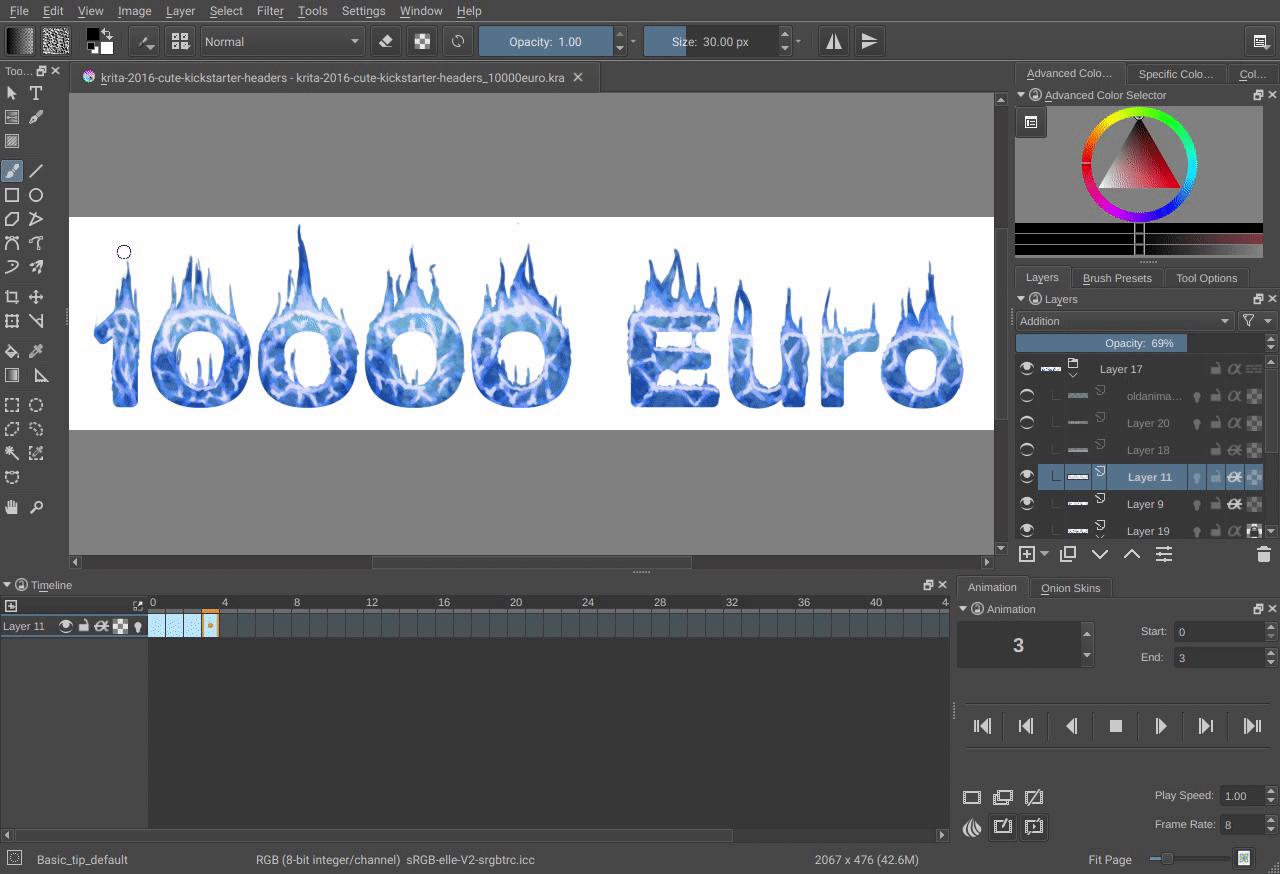
Vi gav också ut vår första och sista verkliga konstbok. En enorm mängd arbete för mig, som började redan 2015 och i slutändan, också en enorm pengaslukare.
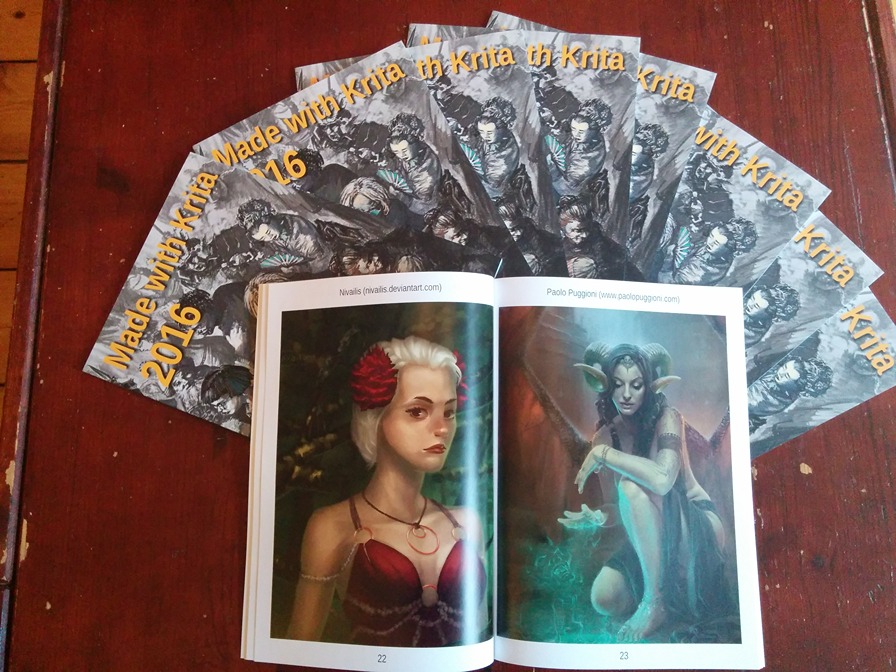
Vi arbetade med förbättrade versioner av Krita 3.0 under hela 2016 och 2017. Även 2018 rullade förbi och vi släppte Krita 4.0, med resultatet av arbete sponsrat av Kickstarter. Fast inte allt, för 2017 var jag upptagen av den stora skattekatastrofen. Det holländska skattekontoret ville att vi skulle betala tiotusentals euro i moms för det arbete Dmitry hade utfört; det var då vi anlitade en ordentlig revisor istället för ett kontor för småföretag i en lokal stad.
När vi offentliggjorde problemen, strömmade bidrag in och PIA gav ett enormt bidrag: de täckte i princip räkningen.
För att undvika att det skulle inträffa igen, flyttade jag all kommersiell verksamhet till ett separat enmansföretag. Det blev ännu viktigare, för 2017 lade vi till Krita i Windows butik. Det var den andra butiken, efter att vi lagt till Krita i Steam butiken 2014. Sedan dess har vi givit ut Krita på Epic butiken, Google Play butiken och nu även på Apple MacOS butiken.
Tiden gick och 2018 släppte vi Krita 4.1, 2019 4.2, 2020 Krita 4.3 och 4.4. Rimligt lugna år av aktiv utveckling, växande användarbas och popularitet. Fler och fler sponsrade utvecklare gick med och Krita gjorde stora framsteg.
Även om Kritas YouTube-kanal redan fanns, bad vi Ramon Miranda att arbeta med regelbundna videor för vår kanal 2019:
Vid det här laget har vi byggt upp en hel lista med imponerande handledningar av alla slag, där vi lär ut allt från själva den digitala målningen till att skapa förinställningar för penslar.
Och sedan avtog utvecklingen. Under 2020 blev effekterna av Covid-19 mer och mer tydliga. Vi kunde inte ha sprintar längre, och alltså inga hyperproduktiva personliga utvecklingssessioner längre. Teammedlemmar blev sjuka, för vissa, riktigt sjuka. Lång Covid har förstört min egen produktivitet: det finns många dagar då jag inte kan göra annat än att ligga i ett mörkt rum.
Även om vi inte hade behövt konvertera Krita till en ny version 2021, bestämde vi oss ändå för att ändra vektorlager från ODG till SVG, vilket gjorde Kritas filer inkompatibla mellan version 4 och 5. En stor förändring i filformat, med andra ord. Vi arbetar fortfarande på nya versioner av Krita 5: 5.1 2022, 5.2 2023.
Framtiden lovar en mycket fin Krita 5.3!
Och också, jämmer och elände, Krita 6.0 eftersom vi har börjat konvertera Krita till Qt6. Och det är inte kul, för Qt6 är återigen en enorm förändring i vad Qt erbjuder och tillåter.
Och det var 25 års arbete med något jag började pyssla med eftersom jag ville rita en karta för en fantasyroman på min bärbara dator!
Gå med i utvecklingsfonden med ett månatligt bidrag. Eller ge ett engångsbidrag här.